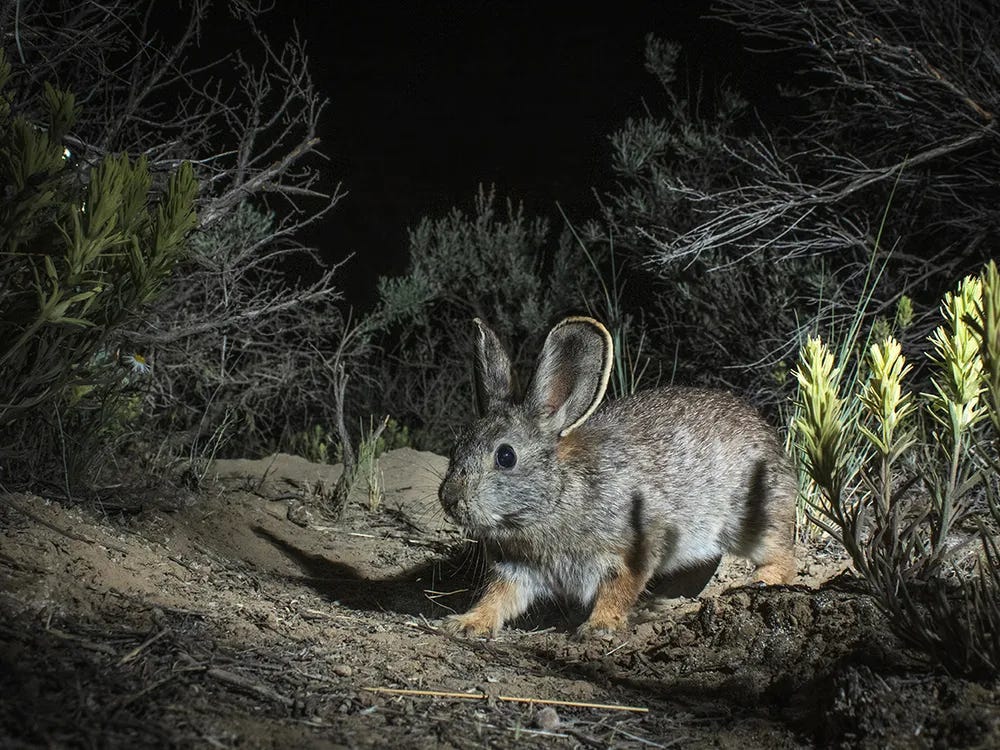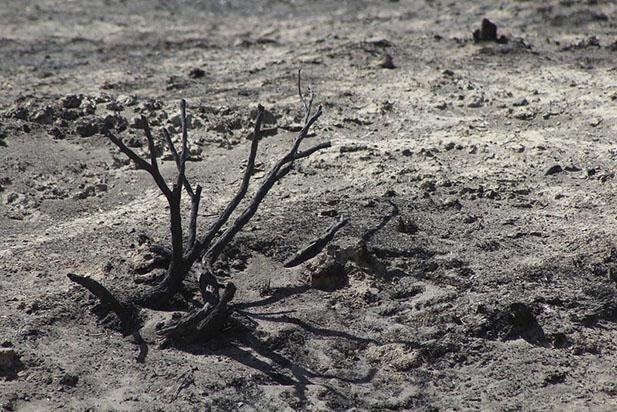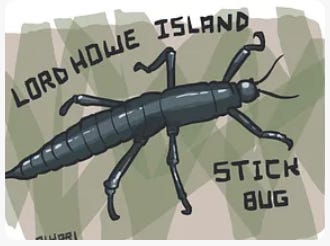Rewilding Stories: The Tiniest Bunny Bounces Back
An occasional series on efforts to rewild the Earth
THERE’S A TROPE in enviro circles: people are only motivated to save charismatic endangered species. Not the endangered slime molds or tree lobsters of the world,1 but the imperiled yet gorgeous polar bears and giraffes. And I am going to play right into that today because, my goodness, have you ever seen a more charismatic endangered animal than this?
We’re speaking, of course, of the Columbia Basin pygmy rabbit. This tiny creature is the smallest North American rabbit and lives only in a limited region of sagebrush sea in eastern Washington state.
The pygmy rabbit depends on the sagebrush sea for, well, everything. Food, shelter, the whole nine yards. To anyone unfamiliar with this ecosystem, it might appear to stretch away to the dusty horizon in an unbroken tableau of knobby gray-green sage bushes and a few scrubby evergreens, with wispy yellowed grass stalks scattered forlornly among them. I sometimes visit eastern Washington, and it always looks like a miracle that anything could wrest a living out of that desiccated dirt.
But in fact, the sagebrush sea is a vibrant ecosystem. There’s just a little remaining — over 80% has been converted to agriculture (and a bit of rural sprawl). The tiniest bunny has thus been squeezed into a tiny corner of its former home, which come to think of it, sounds a lot like how those same ag-driven land grabs squeezed certain humans into tiny corners of their former homes, so, yeah.
Back to the sagebrush sea. My favorite story about pygmy rabbits involves a local guy, Peter Lancaster, who fell in love with them as a kid and spent years as an adult unsuccessfully searching for them in the vast landscapes surrounding his home. Finally, in the late 1990’s, he spotted a single pygmy rabbit, only to literally hear a road grader firing up to clear the land for a housing development. He got in touch with the investor and just like that, purchased the acreage.2
A couple of years later, the federal endangered listing for the rabbits was finalized, and the wheels of the government species-recovery program ground into motion. The very rabbits Lancaster’s land purchase saved (or their descendants) were likely some of the 12 remaining individuals taken into captivity to save the species. He recently donated that parcel to the Nature Conservancy, along with some other land he later bought for the rabbits. The nonprofit conservancy are working with wildlife officials to preserve land for pygmy rabbit habitat, one of the prime goals of the recovery program.
—
SAGEBRUSH IS A PUNGENT and toxic shrub. Pygmy rabbits are one of the few mammals that can eat this tough plant at all and in fact, they are sagebrush-obligate, which means they must have it to survive. In the winter, their diet is composed of 99% sagebrush. In the summer, they supplement with wildflowers and native grasses.
They are the only rabbit species to dig their own (presumably tiny) burrows; they tunnel into the deep soil beneath the sage where they hide from hawks and coyotes and raise wee babies. They are also the only rabbits to climb. Indeed, they are considered arboreal: “old-growth” sagebrush are 3-5 feet (over a meter) tall, a veritable towering tree to a creature that weighs less than a pound (half a kilogram) when full-grown.
—
PERHAPS 100 COLUMBIA BASIN pygmy rabbits remain in just two tiny populations that persist entirely due to captive breeding and reintroduction efforts by state and federal wildlife agencies.3
A third population of the rabbits was killed when a wildfire swept across their home in 2020. According to the state wildlife website, the total population rose as high as 300 in 2018, but after the fire, it’s back down to below 100.
This post is about the Columbia Basin pygmy rabbit. A larger — but sharply declining — population of pygmy rabbits lives more broadly across the Great Basin of the western U.S.4 The Columbia Basin rabbits were isolated from the rest of the pygmy rabbits perhaps as long ago as 115,000 years, when expanding glaciers slid across the Columbia Plateau.
In that time, pygmy rabbits evolved certain characteristics that allow them to survive in the tough landscape of the Columbia Basin. One thing they can’t always survive, however, is our current wildfire regime. Their burrows don’t provide much refuge, and besides, wildfires burn hotter now given the spread of cheatgrass, a highly flammable invasive species first introduced to the region by cattle ranchers. The cheatgrass spread has now reached the mythic proportions of another American invasion: kudzu, a.k.a. “the vine that ate the South.”5 Rabbits can’t live in the burned-over sagebrush sea for up to 20 years post-fire, the time it takes big sagebrush to regrow. And with fires coming every few years or so in our new frequent-fire pattern, well, you see the difficulty.
—
BY THE TIME biologists captured the last 12 Columbia Basin rabbits in 2001, their gene pool was already too small to rebuild a healthy population. This echoes the fate of many a critically endangered species, like the Przewalski’s horse I’ve written about. For the P-horse, one solution involved implanting a decades-old frozen embryo in a quarter horse mother, and then interbreeding the resulting little guy with modern P-horses to increase genetic diversity (once he grew up, of course). Convoluted, to say the least.
To stave off inbreeding among the Columbia Basin rabbits, however, biologists went a different route. They introduced a proportion of Great Basin pygmy rabbit genes into the mix. How much? Well, one source I read stated the current rabbits are 75% Columbia Basin and 25% “other” pygmy rabbit. One publication said they have only 25% Columbia Basin genes. So I sourced a doctoral dissertation on Columbia Basin pygmy rabbit genetics, but I wasn’t able to discern the number there, either.6 So, for our purposes, we can say that no “pure” Columbia Basin rabbits remain, but there are now a few hybrids hopping around out there, fulfilling the same ecological function as their forebears.
The captive breeding program has settled on a “semi-wild” system of enclosures, fenced to deter most predators, and moved as needed to provide fresh sagebrush and prevent buildup of pathogens. From there, biologists take the kits (young rabbits) to suitable habitats and release them, after a quick jab to vaccinate against rabbit hemorrhagic disease, a deadly threat that’s spreading up from the southern United States. The survival rate in their first year of freedom is low, but like their larger cousins, they do breed voluminously.7 So, they’ve got that going for them.
—
ANYTIME HUMANS BRING all remaining known members of a species into captivity and later release them, it begs the question of whether they really exist as a wild species anymore. It seems especially questionable in this case, where no 100% Columbia Basin pygmy rabbits are known to exist any longer. Did we save them from extinction? Yes, in a sense. Are they still wild? Well, yes, in a sense.
recently noted that maybe it’s down to a choice of words shaping how we think about this question, and I think he’s right. Anyway, who are we to deny the value of a species’ existence, truly wild or not, when their extinction or survival is so firmly in our hands? I like Rob’s suggestion to try the word “free.” To me, that honors their existence and gives us something to strive for in this age of unimaginable losses.Jon Gallie is the tireless state wildlife department employee who has led the years-long effort to bring these little ones back home. Like anyone in his position, he’s given thought to many tough questions, but certain answers elude even him:
“When I get asked — ‘Why do we need pygmy rabbits?’ — I don’t always have the best answer,” Gallie said, as fine dust kicked up with each step we took through the sagebrush. “You either value biodiversity or you don’t, and if you don’t, there’s pretty much nothing I can say that’s going to make you go, ‘Oh, now I agree.’ ”8
In some of his last words to us before his death in 2020, Barry Lopez wrote, “I would ask you not to give in to the temptation of despair.”
… in this moment, is it still possible to face the gathering darkness and say to the physical Earth, and to all its creatures, including ourselves, fiercely and without embarrassment, I love you, and to embrace fearlessly the burning world?9
In July 2023, the local paper reported that the most recent round of wildfires had spared the pygmy rabbits. This coming spring, Jon Gallie will head out with his colleagues to release the next generation of bunnies into the wild sagebrush sea. Maybe that’s the only answer we need.
—
H/t to
for this one … the TREE LOBSTER! Shiver, but I’m still glad people are working to protect them.A Big Plan to Save a Tiny Rabbit. Nature Conservancy Magazine.
If you are ever have a million or two to spare, or are in a position to influence whether a legislature funds a wildlife agency, please advocate for as much money as possible to go to their endangered species programs. These folks, in partnership with zoos and universities, are the ones doing the hard field work to save the lost.
Not for nothing, the legal trigger of listing under state or federal endangered species laws is what provides the mandate and initial funding for these recovery efforts. Nonprofit legal organizations that petition the government to protect imperiled wildlife are other worthy recipients of your support.
Conservation groups have petitioned the federal government to list all pygmy rabbits under the Endangered Species Act.
NB: A Smithsonian article suggests that reports of kudzu’s spread have been greatly exaggerated. Thanks to
for the heads up.My inability to figure out the genetic makeup of the pygmy rabbits has nothing to do with the dissertation or its author, and everything to do with my ignorance of the underlying science.
After nearly going extinct, Washington’s pygmy rabbits need room to grow, High Country News.
Lopez, Barry, Embrace Fearlessly the Burning World. Random House Publishing Group. Kindle Edition.














I adored this post, which I just devoured. Thank you. I am always delighted to read rewilding stories from far and wide especially when I have never heard of the animal before. Goodness, these tiny arboreal, sagebrush-obligate bunnies are divine. Thank you also for bringing to my attention the difference between wild and free. In this world, the latter feels very useful.
What a beautiful post. As I read I couldn't stop thinking about the lithium boom. Have you any information on where these restoration efforts are located?
The sagebrush sea is it's own kind of place. I stayed at Thacker Pass for a about eight days, and though the heat was almost overwhelming, I found myself gradually becoming aware of the diverse life around me. Much of it was low to the ground, or underground to avoid the heat, with burrow pits everywhere. There was also an amazing plethora of insects. By the time I left, it felt like the land around me hummed with life.
Thanks for the mention. I should point out that the idea of "free" vs. wild nature is not my idea, just something I've heard here and there.